On August 14, 1865, the Leningrad Zoo was founded, making it one of the oldest zoos in Russia. The zoo was originally opened and maintained with the private funds of Julius and Sophia Gebhardt. For over 50 years, the zoo remained a private institution until 1917, when it was nationalized and transferred under the management of a Scientific Council.
Before the outbreak of the Great Patriotic War, the Leningrad Zoo housed over 440 animals of 140 different species. Despite the challenging times during the siege and war, the zoo continued to operate, closing only briefly during the harsh winter of 1941-1942. Some of its staff even went to the front to fight, leaving the zoo in the hands of dedicated caretakers.
After Leningrad was renamed Saint Petersburg in 1991, it was decided to keep the old name of the zoo as a tribute to the workers who saved the animals during the war. The decision was made to retain the historical significance of the zoo’s name rather than rename it to the Saint Petersburg Zoo.
Today, the Leningrad Zoo is home to approximately 3,000 animals from nearly 600 different species. The zoo attracts around 650,000 visitors annually who come to admire the diverse collection of animals. The zoo continues to be an important cultural institution in Saint Petersburg, providing education and entertainment for visitors of all ages.
Overall, the Leningrad Zoo has a rich history and continues to be a beloved attraction in Saint Petersburg. Its dedication to animal welfare and conservation efforts make it a valuable asset to the city and a must-visit destination for animal lovers and tourists alike.

